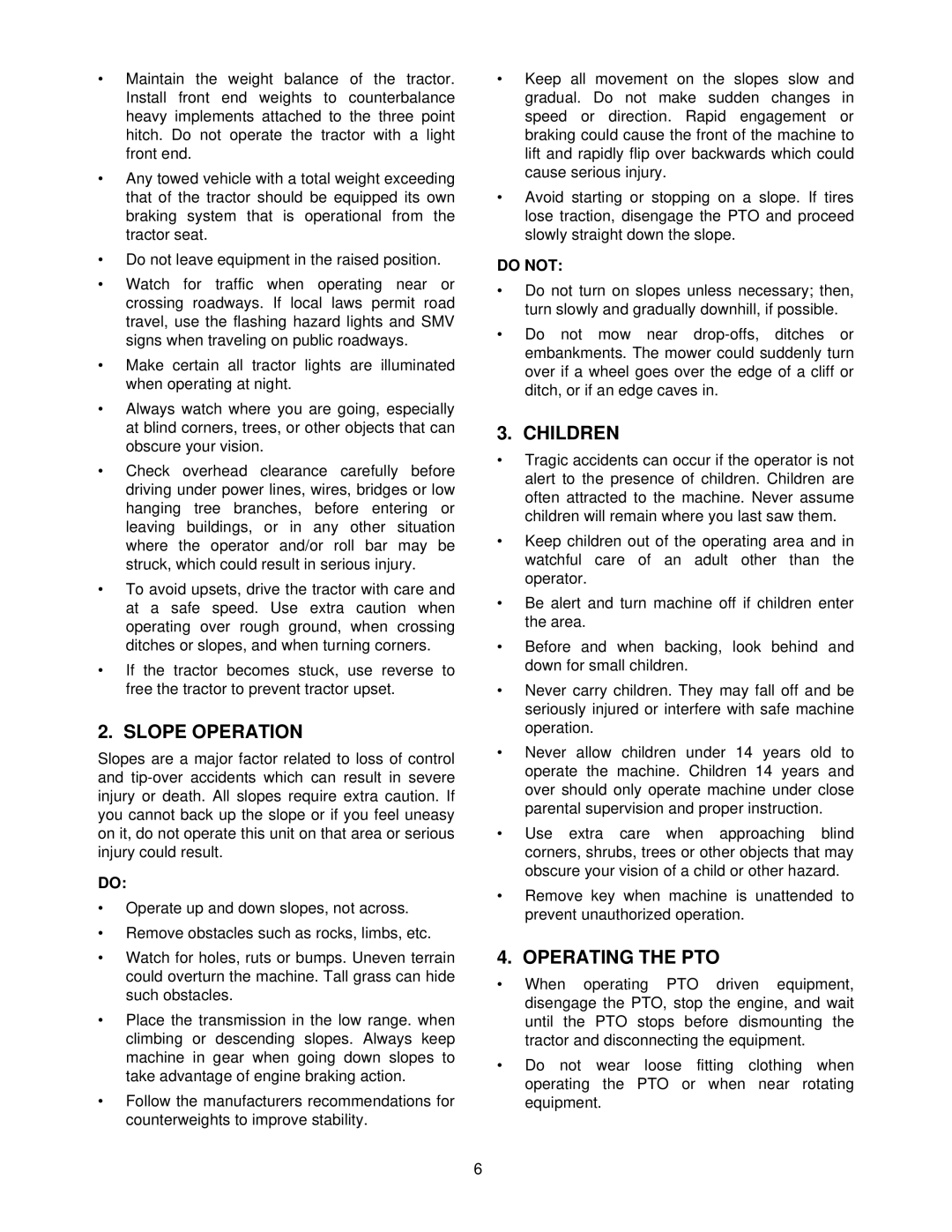•Maintain the weight balance of the tractor. Install front end weights to counterbalance heavy implements attached to the three point hitch. Do not operate the tractor with a light front end.
•Any towed vehicle with a total weight exceeding that of the tractor should be equipped its own braking system that is operational from the tractor seat.
•Do not leave equipment in the raised position.
•Watch for traffic when operating near or crossing roadways. If local laws permit road travel, use the flashing hazard lights and SMV signs when traveling on public roadways.
•Make certain all tractor lights are illuminated when operating at night.
•Always watch where you are going, especially at blind corners, trees, or other objects that can obscure your vision.
•Check overhead clearance carefully before driving under power lines, wires, bridges or low hanging tree branches, before entering or leaving buildings, or in any other situation where the operator and/or roll bar may be struck, which could result in serious injury.
•To avoid upsets, drive the tractor with care and at a safe speed. Use extra caution when operating over rough ground, when crossing ditches or slopes, and when turning corners.
•If the tractor becomes stuck, use reverse to free the tractor to prevent tractor upset.
2. SLOPE OPERATION
Slopes are a major factor related to loss of control and
DO:
•Operate up and down slopes, not across.
•Remove obstacles such as rocks, limbs, etc.
•Watch for holes, ruts or bumps. Uneven terrain could overturn the machine. Tall grass can hide such obstacles.
•Place the transmission in the low range. when climbing or descending slopes. Always keep machine in gear when going down slopes to take advantage of engine braking action.
•Follow the manufacturers recommendations for counterweights to improve stability.
•Keep all movement on the slopes slow and gradual. Do not make sudden changes in speed or direction. Rapid engagement or braking could cause the front of the machine to lift and rapidly flip over backwards which could cause serious injury.
•Avoid starting or stopping on a slope. If tires lose traction, disengage the PTO and proceed slowly straight down the slope.
DO NOT:
•Do not turn on slopes unless necessary; then, turn slowly and gradually downhill, if possible.
•Do not mow near
3. CHILDREN
•Tragic accidents can occur if the operator is not alert to the presence of children. Children are often attracted to the machine. Never assume children will remain where you last saw them.
•Keep children out of the operating area and in watchful care of an adult other than the operator.
•Be alert and turn machine off if children enter the area.
•Before and when backing, look behind and down for small children.
•Never carry children. They may fall off and be seriously injured or interfere with safe machine operation.
•Never allow children under 14 years old to operate the machine. Children 14 years and over should only operate machine under close parental supervision and proper instruction.
•Use extra care when approaching blind corners, shrubs, trees or other objects that may obscure your vision of a child or other hazard.
•Remove key when machine is unattended to prevent unauthorized operation.
4. OPERATING THE PTO
•When operating PTO driven equipment, disengage the PTO, stop the engine, and wait until the PTO stops before dismounting the tractor and disconnecting the equipment.
•Do not wear loose fitting clothing when operating the PTO or when near rotating equipment.
6
